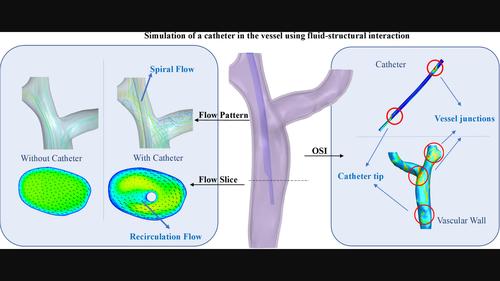当前位置:
X-MOL 学术
›
Int. J. Numer. Method. Biomed. Eng.
›
论文详情
Our official English website, www.x-mol.net, welcomes your feedback! (Note: you will need to create a separate account there.)
Numerical modelling of the interaction between dialysis catheter, vascular vessel and blood considering elastic structural deformation
International Journal for Numerical Methods in Biomedical Engineering ( IF 2.1 ) Pub Date : 2024-03-12 , DOI: 10.1002/cnm.3811 Zihan Chen 1, 2 , Qijun Zheng 1, 2 , Zhenbo Tong 1, 3 , Xianchen Huang 4 , Aibing Yu 1, 2
International Journal for Numerical Methods in Biomedical Engineering ( IF 2.1 ) Pub Date : 2024-03-12 , DOI: 10.1002/cnm.3811 Zihan Chen 1, 2 , Qijun Zheng 1, 2 , Zhenbo Tong 1, 3 , Xianchen Huang 4 , Aibing Yu 1, 2
Affiliation

|
The dialysis catheter indwelling in human bodies has a high risk of inducing thrombus and stenosis. Biomechanical research showed that such physiological complications are triggered by the wall shear stress of the vascular vessel. This study aimed to assess the impact of CVC implantation on central venous haemodynamics and the potential alterations in the haemodynamic environment related to thrombus development. The SVC structure was built from the images from computed tomography. The blood flow was calculated using the Carreau model, and the fluid domain was determined by CFD. The vascular wall and the CVC were computed using FEA. The elastic interaction between the vessel wall and the flow field was considered using FSI simulation. With consideration of the effect of coupling, it was shown that the catheter vibrated in the vascular systems due to the periodic variation of blood pressure, with an amplitude of up to 10% of the vessel width. Spiral flow was observed along the catheter after CVC indwelling, and recirculation flow appeared near the catheter tip. High OSI and WSS regions occurred at the catheter tip and the vascular junction. The arterial lumen tip had a larger effect on the WSS and OSI values on the vascular wall. Considering FSI simulation, the movement of the catheter inside the blood flow was simulated in the deformable vessel. After CVC indwelling, spiral flow and recirculation flow were observed near the regions with high WSS and OSI values.
中文翻译:

考虑弹性结构变形的透析导管、血管和血液之间相互作用的数值模拟
留置在人体内的透析导管诱发血栓和狭窄的风险很高。生物力学研究表明,此类生理并发症是由血管壁剪切应力引发的。本研究旨在评估 CVC 植入对中心静脉血流动力学的影响以及与血栓形成相关的血流动力学环境的潜在变化。SVC 结构是根据计算机断层扫描图像构建的。使用Carreau模型计算血流量,并通过CFD确定流体域。使用 FEA 计算血管壁和 CVC。使用FSI模拟考虑容器壁和流场之间的弹性相互作用。考虑耦合效应,结果表明,由于血压的周期性变化,导管在血管系统中产生振动,其振幅高达血管宽度的10%。CVC留置后沿导管观察到螺旋流,并且在导管尖端附近出现再循环流。高 OSI 和 WSS 区域出现在导管尖端和血管连接处。动脉管腔尖端对血管壁WSS和OSI值影响较大。考虑FSI模拟,在可变形血管中模拟导管在血流中的运动。CVC留置后,在WSS和OSI值较高的区域附近观察到螺旋流和再循环流。
更新日期:2024-03-12
中文翻译:

考虑弹性结构变形的透析导管、血管和血液之间相互作用的数值模拟
留置在人体内的透析导管诱发血栓和狭窄的风险很高。生物力学研究表明,此类生理并发症是由血管壁剪切应力引发的。本研究旨在评估 CVC 植入对中心静脉血流动力学的影响以及与血栓形成相关的血流动力学环境的潜在变化。SVC 结构是根据计算机断层扫描图像构建的。使用Carreau模型计算血流量,并通过CFD确定流体域。使用 FEA 计算血管壁和 CVC。使用FSI模拟考虑容器壁和流场之间的弹性相互作用。考虑耦合效应,结果表明,由于血压的周期性变化,导管在血管系统中产生振动,其振幅高达血管宽度的10%。CVC留置后沿导管观察到螺旋流,并且在导管尖端附近出现再循环流。高 OSI 和 WSS 区域出现在导管尖端和血管连接处。动脉管腔尖端对血管壁WSS和OSI值影响较大。考虑FSI模拟,在可变形血管中模拟导管在血流中的运动。CVC留置后,在WSS和OSI值较高的区域附近观察到螺旋流和再循环流。



























 京公网安备 11010802027423号
京公网安备 11010802027423号